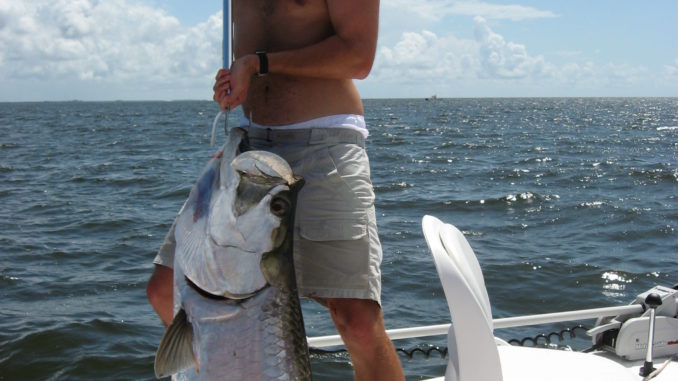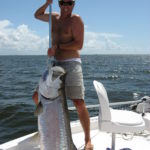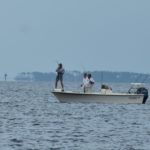
North Carolina anglers have a short window to target tarpon, and that window is about to open.
Fishing spans every type of environment imaginable, with thousands of species to target. For some, all it takes is a fresh cricket or shiny lure to produce a tug on the end of the line, but some species require much more.
In freshwater, the muskellunge ranks at the top of the list for sparse hookup opportunities, being known as the “fish of 10,000 casts.” In North Carolina’s Pamlico Sound and its tributaries, the tarpon occupies that saltwater niche, with only a few hundred fish winding up with a sore mouth annually.
Arriving in late June or early July, depending on water temperature, tarpon migrate north and move through Ocracoke Inlet in huge schools, then break up into smaller groups as they disperse across the sound and into its main tributaries.
Two guides who invest their summers locating and outsmarting tarpon are Mitchell Blake of Inner Banks Fishing Charters and Clay Willis of Salmon Creek Guide Service. In fact, they teamed up to win the 2015 Pamlico Championship Tarpon Tournament Series.
Willis begins looking for the first pod of fish to arrive in the Pamlico and Pungo river systems around Independence Day, when water temperatures are favorable.
“The trigger for the start of the migration is water temperature,” Willis said. “Satellite tagged fish have been consistently tracked along the 79-degree gradient moving north. “In the Pamlico Sound and our area rivers, you’ll see the waters heat up to 79 degrees by the first of July.
“As they move in, we find fish in small schools inside the Pungo River near the reef and within the big square between Indian Island, Able Bay, Pamlico Point and Wades Point in the lower reaches of the Pamlico River.”
Blake fishes the Pamlico, Pungo and Neuse rivers during tarpon season, but the Pamlico and Pungo are his favorites.
“I love the Pamlico/Pungo Area because it is a bottleneck for those fish,” Blake said. “You get a distinct freshwater/saltwater dividing line in the (rivers) that builds a wall where the blue crabs stack up. Tarpon absolutely love crabs.”
During the summer, blue crabs mate and spawn in the river’s brackish zones, setting up a smorgasbord for the incoming tarpon.
“Tarpon orient to the crabs. Finding this freshwater/saltwater line allows anglers to reduce their search area to a much smaller zone. Find the crabs, and the tarpon will be there or on their way at some point though out the day,” Blake said.
The saltwater/freshwater dividing line will not stay constant from day to day. The mixing zone is dynamic and will move based on rainfall and prevailing winds, which is fine with tarpon, highly mobile fish that will travel 5 to 10 miles on a daily basis.
According to Blake, tarpon may not camp out on a food source all day but will arrive at some point, and anglers can be there waiting on them to arrive.
“They will find a sweet spot where the crabs are abundant, they feed up and (then) venture back out into saltier waters,” he said.
Staying on fish from day to day is the best strategy for consistently catching them.
“I devote right much time into this fishery looking at them day after day in the summer across all three of the major river systems. I will find the pods of fish and run with them,” Blake said.
Fortunately for anglers, highly migratory fish like tarpon have a well-developed memory capacity that gives them the ability to recall travel routes and productive feeding areas.
“Tarpon will come back and revisit the same feeding grounds year after year. Places we catch fish in previous years are always go-to places in subsequent years,” Blake said.
While location weighs heavily on catching or not catching fish, having fresh bait and working the lines effectively ranks just as high.
“It really doesn’t matter what kind of fish you use for bait; it just needs to be fresh,” he said.
Willis stocks his boat’s cooler with 50 pounds of restaurant-quality fish: croaker, spot and mullet. Using every last bait on a 12-hour tarpon trip is never a problem.
“You must work the lines to keep the bait fresh and on the hook,” he said. “I use at least six rods at a time, and I change the baits out every 10 to 15 minutes.”
When set up on the right spot, bait will not stay on the hook long. A good tarpon spot will attract many takers: crabs, bluefish, pinfish, sting rays, and other scavengers.
Because opportunities for hookups are somewhat limited, anglers need to have the best baits and the most lines in the water. Willis and Blake will use as many rods as possible, some weighted on the bottom and other floating near the surface to cover as much water as possible.
“We don’t get too many opportunities at these fish, so we take the shotgun approach,” Blake said.
Because tarpon travel in small pods, when they set up to feed, anglers need to take full advantage of the opportunity, often getting multiple hookups simultaneously. Blake always keeps fresh baits soaking when an angler is hooked up.
“Stay on anchor the best you can, because these fish travel in schools. If you are confident in what you are doing, you can double up,” Blake said.
DESTINATION INFORMATION
HOW TO GET THERE — U.S. 64 out of Raleigh and US 264 out of Wilson will put fishermen along the western edge of Pamlico Sound. Public boat ramps that provide easy access to the sound’s tarpon waters are located in almost every corner of Carteret, Hyde and Pamlico counties. County, including Cedar Island, Oriental, Hobucken, Rose Bay, Washington and Belhaven. Visit www.ncwildlife.org/Boating_Waterways/Boating_Maps_Locations.htm. When fishing, look for places where crabs are abundant. The saltwater/freshwater dividing line in the Pamlico and Pungo rivers can be very productive.
WHEN TO GO — Tarpon begin trickling into the Pamlico Sound as early as late June, with mid-July through Labor Day being the peak season. The first cold front of the fall will push them south.
BEST TECHNIQUES — Fresh, restaurant-quality bait is crucial for connecting with tarpon. Croaker, mullet, menhaden and spot are ideal. Small chunks of fresh bait should be pinned on 6/0 to 8/0 super-sharp J-hooks or an octopus circle hooks. Leaders should be 6 to 8 feet of 60-pound or stronger. Use a spread of weighted and unweighted baits to cover different parts of the water column. Medium-heavy to heavy spinning or baitcasting tackle is required. Line on a high-capacity reel is 20- to 30-pound test. Shock leaders can be tied to the main line using a line-to-line knot such as double surgeon’s, Albright or double Uni knot.
FISHING INFO/GUIDES — Mitchell Blake, Inner Banks Fishing Charters, 252-495-1803, www.easternncfishingguide.com; Clay Willis, Salmon Creek Guide Service, 252-312-3692; George Beckwith, Down East Guide Service, 252-671-3474, www.pamlicoguide.com. See also Guides and Charters in Classifieds.
ACCOMMODATIONS — Hampton Inn, Washington, 252-940-4556; Pamlico County Chamber of Commerce, www.pamlicochamber.com; Belhaven Community Chamber of Commercie, www.belhavenchamber.com; Visiting Washington, www.visitwashingtonnc.com.
MAPS — Capt. Segull’s Nautical Charts, 888-473-4855, www.captainsegullcharts.com; GMCO’s Chartbook of North Carolina, www.gmcomaps.com.




Be the first to comment